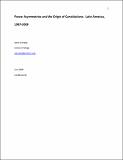| dc.description.abstract |
This article explores the origins of constitutions, and within them, levels of power concentration in the Executive branch. By looking at the 10 cases of constitutional rewrite in Latin America and several cases of aborted change since the 1980s, I develop a theory of constitutional change based on the notion of power asymmetries, defined as the power differential between incumbents and opposition forces at the negotiations. Under conditions of reduced power asymmetry, i.e., when both incumbents and opposition forces enjoy comparable levels of power, constituent assemblies are more likely to yield constitutions that curtail presidential powers relative to the status quo. When the opposition is weak, assemblies will instead expand presidential powers. When the incumbent is weak, he or she will abort the process of constitutional rewrite. I conclude with a brief discussion of how this finding challenges some structuralist prescriptions for democratic renewal. |

